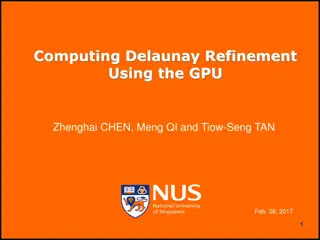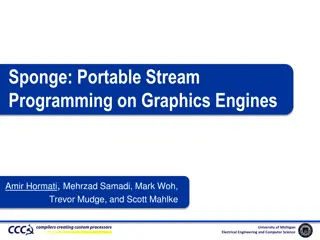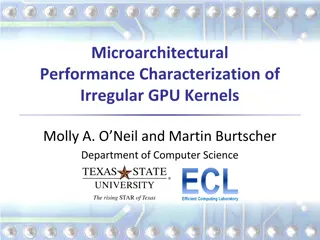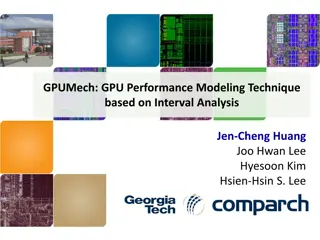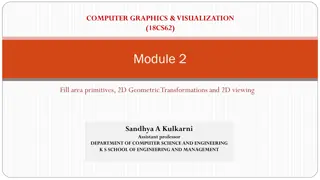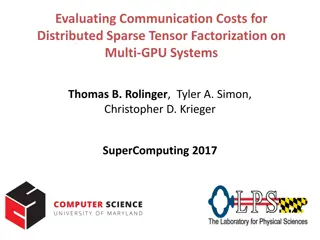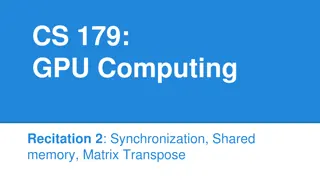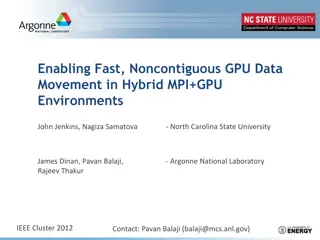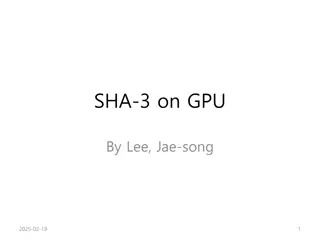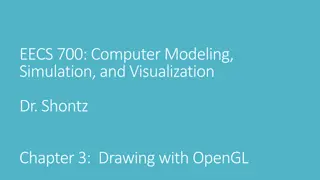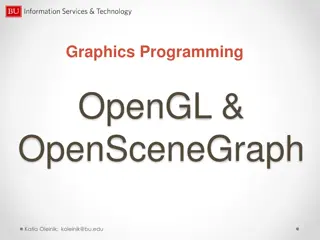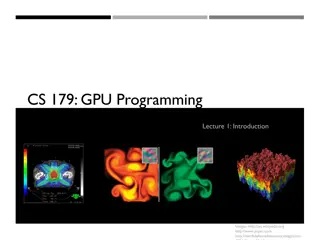
GPU Programming Primitives for Computer Graphics
This book covers advanced topics in GPU programming for computer graphics, including parallel reduction, prefix scan, programming primitives, linear probing, radix sort, and code optimization. It delves into the motivation behind leveraging thousands of threads on GPUs and addresses various challenges in writing parallel code efficiently. With insights into HIP - a C++ API for GPU computing - and practical course resources, this publication offers a comprehensive guide for mastering GPU programming primitives in the context of computer graphics.
Download Presentation

Please find below an Image/Link to download the presentation.
The content on the website is provided AS IS for your information and personal use only. It may not be sold, licensed, or shared on other websites without obtaining consent from the author. If you encounter any issues during the download, it is possible that the publisher has removed the file from their server.
You are allowed to download the files provided on this website for personal or commercial use, subject to the condition that they are used lawfully. All files are the property of their respective owners.
The content on the website is provided AS IS for your information and personal use only. It may not be sold, licensed, or shared on other websites without obtaining consent from the author.
E N D
Presentation Transcript
GPU PROGRAMMING PRIMITIVES FOR COMPUTER GRAPHICS Daniel Meister | Atsushi Yoshimura | Chih-Chen Kao Advanced Micro Devices, Inc. Advanced Rendering Research Group (ARR) 1
2 INTRODUCTION
3 COURSE SYLLABUS - Introduction (~15 min, Daniel) - Parallel reduction and prefix scan (~25 min, Daniel) - Programming primitives (~25 min, Daniel & Atsushi) - Linear probing (~20 min, Atsushi) - Radix sort (~15 min, Atsushi) - Code optimization (~10 min, Atsushi) - Q&A (~10 min) SIGGRAPH ASIA 2023 GPU PROGRAMMING PRIMITIVES FOR COMPUTER GRAPHICS
4 MOTIVATION - Thousands of threads running simultaneously on the GPU - Trivial single-threaded operations might be non-trivial on the GPU - Different algorithms often deal with similar problems - How to write output in parallel? - How to find minimum, maximum, or sum? - How to sort elements? - How to map data to threads/warps/blocks? - The same patterns observed in different algorithms SIGGRAPH ASIA 2023 GPU PROGRAMMING PRIMITIVES FOR COMPUTER GRAPHICS
5 COURSE RESOURCES - Course notes: https://gpu-primitives-course.github.io - Presentation slide in PPT with animations - PDF with additional notes - Code samples: - Buildable code presented in the slides - Performance comparison of different variants SIGGRAPH ASIA 2023 GPU PROGRAMMING PRIMITIVES FOR COMPUTER GRAPHICS
6 HIP (HETEROGENEOUS-COMPUTE INTERFACE FOR PORTABILITY) int* out; hipMalloc(&out, sizeof(int)); ... HIP is a C++ API and kernel language for GPU computing - Syntactically similar to CUDA Portable C++ (HIP Syntax) - Supports most of the CUDA runtime functionality - Portable applications for AMD and CUDA devices - CUDA wrapper is provided CUDA wrapper inline static hipError_t hipMalloc(void** ptr, size_t size) { return hipCUDAErrorTohipError(cudaMalloc(ptr, size)); } NVCC HIPCC Runtime API Driver API Runtime API Driver API NVIDIA GPU AMD GPU SIGGRAPH ASIA 2023 GPU PROGRAMMING PRIMITIVES FOR COMPUTER GRAPHICS
7 HIP RUNTIME API KERNEL EXAMPLE A counterpart to the CUDA runtime API #include <hip/hip_runtime.h> - Host calls are prefixed with hip instead of cuda __device__ int threadIndex() { return threadIdx.x + blockIdx.x * blockDim.x; } Kernel compatibility __global__ void Kernel(int* out) { int index = threadIndex(); if (index == 0) *out = warpSize; } - Same built-in variables - thread index, block index, and block size - Functions specifiers such as __global__ and __device__ cudaMalloc(&out, sizeof(int)); Kernel<<<1, 64>>>(out); cudaFree(out); int main() { int* out; hipMalloc(&out, sizeof(int)); Kernel<<<1, 64>>>(out); hipFree(out); return 0; } - Kernel launch via <<< >>> specifying the grid and block resolutions SIGGRAPH ASIA 2023 GPU PROGRAMMING PRIMITIVES FOR COMPUTER GRAPHICS
8 HIP DRIVER API KERNEL EXAMPLE const char* code = ... const char* funcname = ... A counterpart to the CUDA driver API nvrtcCreateProgram(&prog, - Host calls are prefixed with hip or hiprtc instead of cu and nvrtc hiprtcProgram prog; hiprtcCreateProgram( &prog, code, "", 0, nullptr, nullptr); hiprtcCompileProgram(prog, 0, nullptr); - Kernels compiled in runtime via hiprtc (similar to nvrtc) and launched via hipModuleLaunchKernel size_t binarySize = 0; hiprtcGetCodeSize(prog, &binarySize); std::vector<std::byte> binary(binarySize); hiprtcGetCode(prog, binary.data()); hipModule_t module; hipModuleLoadData(&module, binary.data()); cuModuleGetFunction(&func, hipFunction_t func; hipModuleGetFunction(&func, module, funcname); cuLaunchKernel(func, 1, 1, 1, void* args[] = { &out }; hipModuleLaunchKernel(func, 1, 1, 1, 64, 1, 1, 0, 0, reinterpret_cast<void**>(args), 0); SIGGRAPH ASIA 2023 GPU PROGRAMMING PRIMITIVES FOR COMPUTER GRAPHICS
9 OROCHI Portable C++ ( HIP Syntax ) Portable C++ (Orochi syntax) CUDA/HIP software builds with each SDK - Separate compilation for HIP and CUDA (two binaries) - Recompiling the program to switch platforms Single executable An executable with Orochi CUDA Wrapper Orochi API Orochi NVCC HIPCC - A library loading HIP and CUDA dlls dynamically Runtime API Driver API Driver API Runtime API Driver API Driver API - Switching between HIP and CUDA in runtime (one binary) An executable with CUDA SDK An executable with HIP SDK Multiple executables NVIDIA GPU AMD GPU SIGGRAPH ASIA 2023 GPU PROGRAMMING PRIMITIVES FOR COMPUTER GRAPHICS
10 OROCHI KERNEL EXAMPLE const char* code = ... const char* funcname = ... The same as HIP driver API - Host calls are prefixed with oro instead of hip or cu orortcProgram prog; orortcCreateProgram( &prog, code, "", 0, nullptr, nullptr); orortcCompileProgram(prog, 0, nullptr); size_t binarySize = 0; orortcGetCodeSize(prog, &binarySize); std::vector<std::byte> binary(binarySize); orortcGetCode(prog, binary.data()); oroModule module; oroModuleLoadData(&module, binary.data()); oroFunction func; oroModuleGetFunction(&func, module, funcname); void* args[] = { &out }; oroModuleLaunchKernel(func, 1, 1, 1, 64, 1, 1, 0, 0, reinterpret_cast<void**>(args), 0); SIGGRAPH ASIA 2023 GPU PROGRAMMING PRIMITIVES FOR COMPUTER GRAPHICS
11 HIP/CUDA PROGRAMMING MODEL grid - Multi-level hierarchy block (0,0) thread (0,0) block (1,0) thread (0,0) - The thread is the smallest unit of program execution thread (1,0) thread (1,0) - Threads are organized in a block thread (0,1) thread (1,1) thread (0,1) thread (1,1) - Blocks form a grid - Block and grid have up to three dimensions - Threads within a block are further implicitly divided into warps (32 or 64 threads) block (0,1) thread (0,0) block (1,1) thread (0,0) thread (1,0) thread (1,0) - A certain level of granularity thread (0,1) thread (1,1) thread (0,1) thread (1,1) thread (warp 0) (0,0) (31,0) SIGGRAPH ASIA 2023 GPU PROGRAMMING PRIMITIVES FOR COMPUTER GRAPHICS
12 HIP/CUDA MEMORY MODEL - Define memory hierarchy - Registers (VGPR, SGPR) - Local variables per thread - The fastest memory - Local memory - local variables per thread - Slow off-chip memory (VRAM) - Register spills if not enough registers - Shared memory (Local data share) - Shared between threads in a block - Faster on-chip memory - Global memory - Shared with all blocks - Largest memory - Slow off-chip memory (VRAM) - Texture and constant memory - Cached differently, on off-chip memory grid block (0,0) block (n,0) shared memory shared memory registers registers registers registers thread thread thread thread local memory local memory local memory local memory global memory constant memory texture memory SIGGRAPH ASIA 2023 GPU PROGRAMMING PRIMITIVES FOR COMPUTER GRAPHICS
13 Blocks for a computing task HIP/CUDA EXECUTION MODEL block (n-3,0) block (16,0) block (0,0) - Mapping blocks of threads to streaming multiprocessors (SMs) block (n-2,0) block (17,0) block (1,0) - Streaming multiprocessors block (18,0) block (2,0) block (n-1,0) - Streaming processors - Registers - Shared memory GPU - Single-instruction-multiple-threads (SIMT) streaming multiprocessor (n-1) streaming multiprocessor (0) streaming multiprocessor (1) - Process warps (32 or 64 threads) streaming multiprocessor constant cache block (0,0) shared memory thread (warp 0) (0,0) (1,0) (31,0) streaming processor streaming processor texture cache thread (warp 1) (32,0) (33,0) (63,0) device memory registers SIGGRAPH ASIA 2023 GPU PROGRAMMING PRIMITIVES FOR COMPUTER GRAPHICS
14 HIP KEY COMPONENTS - Atomic operations - Guarantee correctness even in a highly parallel environment - Shared memory - Temporal memory for sharing data in the same block - Warp-level primitives - Low-level control of warp execution - Inter-warp communication between threads SIGGRAPH ASIA 2023 GPU PROGRAMMING PRIMITIVES FOR COMPUTER GRAPHICS
15 ATOMIC OPERATIONS - Even a trivial operation may consist of multiple instructions __global__ void DotProductKernel(int size, float* x, float* y, float* out) { int index = threadIdx.x + blockIdx.x * blockDim.x; if (index < size) atomicAdd(out, x[index] * y[index]); } Multiple threads may process simultaneously - Concurrent execution by multiple threads may lead to undesirable results (race conditions). - X += Y - Addition consists of three steps: - Reading a value of X - Adding Y to this value - Writing the result back to X - Atomic operations (or atomics) guarantee that the operation is correctly processed in parallel execution - atomicAdd(), atomicMin(), atomicMax(), atomicExch(), atomicCAS(), etc. SIGGRAPH ASIA 2023 GPU PROGRAMMING PRIMITIVES FOR COMPUTER GRAPHICS
16 SHARED MEMORY Memory shared among the threads in the same block - Can be used for accumulators, communicating between threads - __syncthreads() guarantees IO operations have been completed in the block by synchronizing threads - Some threads in a block may go forward than others constexpr int BLOCK_SIZE = 64; __global__ void DotProductKernel(int size, float* x, float* y, float* out) { int index = threadIdx.x + blockIdx.x * blockDim.x; __shared__ float smem[BLOCK_SIZE]; float val = 0.0f; if (index < size) val = x[index] * y[index]; smem[threadIdx.x] = val; __syncthreads(); Shared memory Write & sync write data if (threadIdx.x == 0) { float sum = 0.0f for (int i = 0; i < blockDim.x; ++i) sum += smem[i]; atomicAdd(out, sum) } } __syncthreads() read data Read data A block SIGGRAPH ASIA 2023 GPU PROGRAMMING PRIMITIVES FOR COMPUTER GRAPHICS
17 WARP-LEVEL PRIMITIVES Efficient operations within a warp __global__ void DotProductKernel (int size, float* x, float* y, float* out) { int index = threadIdx.x + blockIdx.x * blockDim.x; int laneIndex = threadIdx.x & (warpSize 1); float val = 0.0f; if (index < size) val = x[index] * y[index]; float sum = 0.0f for (int i = 0; i < warpSize; ++i) sum += __shfl(val, i); if (laneIndex == 0) atomicAdd(out, sum) } - __shfl*(): Allows threads to read local registers of another thread in the same warp (no need for shared memory!) - __ballot(): Binary voting within the warp - __any() and __all(): Logic quantifiers for the warp Still sequential work x Read data from a specific thread 1 0 0 1 0 1 0 1 = __ballot(x) = 0x95 Need more parallelism for further optimization The voting results are packed as a bitmask and returned to threads. SIGGRAPH ASIA 2023 GPU PROGRAMMING PRIMITIVES FOR COMPUTER GRAPHICS
18 PARALLEL REDUCTION & PREFIX SCAN
19 PARALLEL REDUCTION (PR) add, min, max, .. ?0,?1, ,?? 1 - Input: An array of values and associative operator ?0 ?1 ?? 1 - Output: 8 1 7 4 6 3 5 2 9 7 9 11 20 16 36 SIGGRAPH ASIA 2023 GPU PROGRAMMING PRIMITIVES FOR COMPUTER GRAPHICS
20 PARALLEL REDUCTION (PR) TIME COMPLEXITY ? ? - Sequential algorithm - Parallel algorithm - for processors ? log? ?/2 ? < ?/2 ? - for processors and ? ?/? + log? 8 1 7 4 6 3 5 2 9 7 9 11 log2 ? Depth of recursion 20 16 36 SIGGRAPH ASIA 2023 GPU PROGRAMMING PRIMITIVES FOR COMPUTER GRAPHICS
21 PARALLEL REDUCTION (PR) AXIS-ALIGNED BOUNDING BOX Axis-aligned bounding box (AABB) - Defined by minimum and maximum (red dots) - Can be computed by parallel reduction - Minimum and maximum for each axis - Six parallel reductions in 3D SIGGRAPH ASIA 2023 GPU PROGRAMMING PRIMITIVES FOR COMPUTER GRAPHICS
22 PARALLEL REDUCTION (PR) IMPLEMENTATION Block-wise reduction with shared memory [0] [3] [2] [1] [6] [4] [7] [5] - Shared memory for intermediate computations 001 010 011 000 101 110 111 100 i = 001 template <typename T> __device__ T ReduceSumBlock(T val, T* smem) { smem[threadIdx.x] = val; __syncthreads(); Shared Memory [0-1] [6-7] [2-3] [4-5] for (int i = 1; i < blockDim.x; i *= 2) { if (threadIdx.x < (threadIdx.x ^ i)) smem[threadIdx.x] += smem[threadIdx.x ^ i]; __syncthreads(); } Make pairs 001 010 011 000 101 110 111 100 i = 010 [0-3] [4-7] Any associative operator return smem[0]; } 001 010 011 000 101 110 111 100 i = 100 [0-7] SIGGRAPH ASIA 2023 GPU PROGRAMMING PRIMITIVES FOR COMPUTER GRAPHICS
23 PARALLEL REDUCTION (PR) IMPLEMENTATION Warp-wise reduction with shuffle [0] [3] [2] [1] [6] [4] [7] [5] - Directly reading registers of other threads 001 010 011 000 101 110 111 100 i = 001 template <typename T> __device__ T ReduceSumWarp(T val) { for (int i = 1; i < warpSize; i *= 2) { val += __shfl_xor(val, i); } return val; } __shfl(val, laneIndex ^ i) [0-1] [0-1] [4-5] [6-7] [6-7] [2-3] [4-5] [2-3] 001 010 011 000 101 110 111 100 i = 010 [0-3] [0-3] [4-7] [4-7] [4-7] [0-3] [4-7] [0-3] 001 010 011 000 101 110 111 100 i = 100 [0-7] [0-7] [0-7] [0-7] [0-7] [0-7] [0-7] [0-7] SIGGRAPH ASIA 2023 GPU PROGRAMMING PRIMITIVES FOR COMPUTER GRAPHICS
24 PREFIX SCAN ?0,?1, ,?? 1 - Input: An array of values and associative operator ?0, ?0 ?1, , ?0 ?1 ?? 1 - Inclusive prefix scan: ?,?0, ?0 ?1, , ?0 ?1 ?? 2 - Exclusive prefix scan: ? ?? ? = ? ?? = ?? - Identity element 8 1 7 4 6 3 5 2 Inclusive prefix scan 8 9 16 20 26 29 34 36 Exclusive prefix scan 0 8 9 16 20 26 29 34 SIGGRAPH ASIA 2023 GPU PROGRAMMING PRIMITIVES FOR COMPUTER GRAPHICS
25 PARALLEL PREFIX SCAN (PPS) TIME COMPLEXITY - Two parallel algorithms: ? ? - Sequential algorithm - Hillis-Steele algorithm - Parallel algorithm - Blelloch s algorithm - for processors ? log? ?/2 ? < ?/2 ? - for processors and ? ?/? + log? 8 1 7 4 6 3 5 2 Inclusive prefix scan 8 9 16 20 26 29 34 36 Exclusive prefix scan 0 8 9 16 20 26 29 34 SIGGRAPH ASIA 2023 GPU PROGRAMMING PRIMITIVES FOR COMPUTER GRAPHICS
26 HILLIS-STEELE ALGORITHM - Inclusive prefix scan - Computational steps ? ?log? - One pass 8 8 8 1 1 1 7 7 7 4 4 4 6 6 6 3 3 3 5 5 2 2 7 7 8 9 9 9 8 10 9 9 9 8 11 11 11 16 16 16 18 20 20 18 8 9 9 20 20 36 36 16 26 29 29 34 8 9 20 SIGGRAPH ASIA 2023 GPU PROGRAMMING PRIMITIVES FOR COMPUTER GRAPHICS
27 HILLIS-STEELE ALGORITHM IMPLEMENTATION Block-wise prefix scan with shared memory - Shared memory for intermediate computations template <typename T> __device__ T ScanBlock_HillisSteele(T val, T* smem) { smem[threadIdx.x] = val; __syncthreads(); 8 1 7 4 6 3 5 2 offset=1 7 8 9 8 10 9 8 11 offset=2 for (int offset = 1; offset < blockDim.x; offset *= 2) { if (threadIdx.x offset >= 0) val += smem[threadIdx.x - offset]; 16 16 18 20 18 8 9 20 offset=4 36 16 26 29 34 8 9 20 __syncthreads(); smem[threadIdx.x] = val; __syncthreads(); } return smem[threadIdx.x]; } SIGGRAPH ASIA 2023 GPU PROGRAMMING PRIMITIVES FOR COMPUTER GRAPHICS
28 HILLIS-STEELE ALGORITHM IMPLEMENTATION Warp-wise prefix scan with shuffle - Directly reading registers of other threads 8 1 7 4 6 3 5 2 template <typename T> __device__ T ScanWarp_HillisSteele (T val) { int laneIndex = threadIdx.x & (warpSize 1); for (int offset = 1; offset < warpSize; offset *= 2) { T paired = __shfl_up(val, offset); if (laneIndex offset >= 0) val += paired; } return val; } offset=1 7 8 9 8 10 9 8 11 offset=2 16 16 18 20 18 8 9 20 offset=4 36 16 26 29 34 8 9 20 __shfl(val, laneIndex - offset) SIGGRAPH ASIA 2023 GPU PROGRAMMING PRIMITIVES FOR COMPUTER GRAPHICS
29 WARP-WISE BINARY PPS IMPLEMENTATION [7] [6] [5] [3] [2] [4] [1] [0] - A special case of prefix scan with binary values (0 or 1) x - __ballot: bits indicating how threads voted - __popc: the number of bits set to one 1 0 0 1 0 1 0 1 ballot(x) = __device__ int ScanWarpBinary(bool x) { int laneIndex = threadIdx.x & (warpSize 1); uint64_t ballot = __ballot(x); return __popcll(ballot & ((1ull << laneIndex) 1)); } Threads: [0] 0 = POPC ( ) 1 0 0 1 0 1 0 1 [1] 1 = POPC ( ) 1 0 0 1 0 1 0 1 [2] 1 = POPC ( ) 1 0 0 1 0 1 0 1 laneIndex=0 -> 00000000 laneIndex=1 -> 00000001 laneIndex=2 -> 00000011 laneIndex=3 -> 00000111 laneIndex=4 -> 00001111 [3] 2 = POPC ( ) 1 0 0 1 0 1 0 1 [4] 2 = POPC ( ) 1 0 0 1 0 1 0 1 SIGGRAPH ASIA 2023 GPU PROGRAMMING PRIMITIVES FOR COMPUTER GRAPHICS
30 DEVICE-WISE PARALLEL PREFIX SCAN HIERARCHICAL APPROACH Input 8 1 7 4 6 3 5 2 9 Block-wise prefix scans 20 10 26 13 29 34 36 16 45 8 9 16 4 5 7 Block sums 16 13 16 Adding offsets to block prefix scans Prefix scan of the sums (block offsets) 0 16 29 45 SIGGRAPH ASIA 2023 GPU PROGRAMMING PRIMITIVES FOR COMPUTER GRAPHICS
31 DEVICE-WISE PARALLEL PREFIX SCAN PARTIALLY SEQUENTIAL APPROACH Input 8 1 7 4 6 3 5 2 9 Block-wise prefix scans 4 4 10 10 13 13 5 5 7 7 16 16 8 9 16 Global offset += 16 Global offset calculation Global offset += 13 Global offset += 16 + Offset (16 + 13) + Offset (0) + Offset (16) Apply the offset 34 36 45 8 9 16 20 26 29 SIGGRAPH ASIA 2023 GPU PROGRAMMING PRIMITIVES FOR COMPUTER GRAPHICS
32 DEVICE-WISE PARALLEL PREFIX SCAN IMPLEMENTATION Device-wise prefix scan - Hierarchical approach template <typename T> __device__ T ScanDevice (T val, T* smem, T* sum, int* counter) { val = ScanBlock(val, smem); __shared__ T offset; if (threadIdx.x == blockDim.x - 1) { while (atomicAdd(counter, 0) < blockIdx.x); __threadfence(); - Prefix scan of block sums - Multiple kernel launches Parallel execution - For large inputs we need more than two levels - Sequential approach - Wait for the block offset using atomic counter - Add the block sum obtaining the block offset offset = *sum; *sum += val; __threadfence(); atomicAdd(counter, 1); } __syncthreads(); return offset + val; } - Add the block offset and block values to obtain the global prefix scan - Only one kernel launch Synchronization for sequential execution - Both approaches can be implemented as an in-place algorithm Parallel execution SIGGRAPH ASIA 2023 GPU PROGRAMMING PRIMITIVES FOR COMPUTER GRAPHICS
33 PROGRAMMING PRIMITIVES
34 PARALLEL ENQUEUING Na ve solution with atomic add - Writing an output is one of the most common tasks in parallel computing __global__ void EnqueueNaiveKernel(const int* input, int* output, int* counter) { int value = - Task queue, tree constructions, etc. - Non-trivial if not all threads want to write bool enqueue = /* ANY CONDITION HERE */; if (enqueue) output[atomicAdd(counter, 1)] = value; } Per thread - Na ve solution is to use atomic add to get the offset - Better solution is to use warp-wise with atomic add - Device-wise prefix scan is not necessary - Block-wise or warp-wise are sufficient Input buffer Output buffer SIGGRAPH ASIA 2023 GPU PROGRAMMING PRIMITIVES FOR COMPUTER GRAPHICS
35 PARALLEL ENQUEUING IMPLEMENTATION Binary warp-wise prefix scan with atomic add and shuffle Warp-wise prefix scan with atomic add and shuffle __global__ void EnqueueBinaryKernel(int size, const int* input, int* output, int* counter) { int index = threadIdx.x + blockDim.x * blockIdx.x; int laneIndex = threadIdx.x & (warpSize - 1); __global__ void EnqueueKernel(int size, const int* input, int* output, int* counter) { int val0 = , val1 = ; up to two items Each threads outputs bool enqueue0 = /* ANY CONDITION HERE */; bool enqueue1 = /* ANY CONDITION HERE */; int enqueuedCount = enqueue0 + enqueue1; int val = 0; if (index < size) val = input[index]; bool enqueue = /* ANY CONDITION HERE */; int warpScan = ScanWarpBinary(enqueue); int warpScan = ScanWarp(enqueuedCount) - enqueuedCount; Include the current value of the last lane int warpOffset = 0; if (laneIndex == warpSize - 1) warpOffset = atomicAdd( warpOffset = __shfl(warpOffset, warpSize - 1); int warpOffset = 0; if( laneIndex == warpSize - 1) warpOffset = atomicAdd(counter, warpScan + enqueuedCount); warpOffset = __shfl(warpOffset, warpSize - 1); counter, warpScan + enqueue); int offset = warpOffset + warpScan; if(index0 < size && enqueue0) output[offset++] = val0; if(index1 < size && enqueue1) output[offset] = val1; } if (index < size && enqueue) output[warpOffset + warpScan] = val; } SIGGRAPH ASIA 2023 GPU PROGRAMMING PRIMITIVES FOR COMPUTER GRAPHICS
36 PARALLEL ENQUEUING COMPLEMENT Binary warp-wise prefix scan with its complement - Sometimes we want to output data to either one of buffer or to another one __global__ void EnqueueComplementKernel(int size, const int* input, int* output0, int* output1, int* counters) { int index = threadIdx.x + blockDim.x * blockIdx.x; int laneIndex = threadIdx.x & (warpSize - 1); - We can use just one prefix scan and its complement instead of two prefix scans i-th element int val = 0; if (index < size) val = input[index]; int complWarpScan = ScanWarpBinary(!enqueue); ? ? 1 ?? = ? ?? bool enqueue = /* ANY CONDITION HERE */; int warpScan = ScanWarpBinary(enqueue); int complWarpScan = laneIndex - warpScan; ?=0 ?=0 int warpOffset = /* THE SAME AS BEFORE */; Red output buffer int complWarpOffset = 0; if (laneIndex == warpSize - 1) complWarpOffset = atomicAdd(&counters[1], complWarpScan + !enqueue); complWarpOffset = __shfl(complWarpOffset, warpSize - 1); Input buffer if (index < size) { if (enqueue) output0[warpOffset + warpScan] = val; else output1[complWarpOffset + complWarpScan] = val; } } Green output buffer SIGGRAPH ASIA 2023 GPU PROGRAMMING PRIMITIVES FOR COMPUTER GRAPHICS
37 BOTTOM-UP TRAVERSAL - In computer graphics, we often arrange data into hierarchical structures - Reduction of leaf nodes in the corresponding subtrees - Refitting bounding boxes - The sum of surface areas 36 - The number of primitives 20 16 9 11 9 7 8 1 7 4 6 3 2 5 SIGGRAPH ASIA 2023 GPU PROGRAMMING PRIMITIVES FOR COMPUTER GRAPHICS
38 BOTTOM-UP TRAVERSAL - IMPLEMENTATION Summing up values in all the leaf nodes __global__ void BottomUpTraversalKernel(int size, const Node* nodes, const Leaf* leaves, int* sums, int* counters) { int index = threadIdx.x + blockDim.x * blockIdx.x; if (index >= size) return; - Counters in interior nodes (initialized to 0) and parent links - Each thread is assigned to a leaf node proceeding up to the root const Leaf& leaf = leaves[index]; index = leaf.m_parentAddr; - In internal node, the thread atomically increment the counter while (index >= 0 && atomicAdd(&counters[index], 1) > 0) { __threadfence(); - Allowing only the last thread processes the internal node const Node& node = nodes[index]; int sum = 0; if (node.leftIsLeaf()) sum += leaves[node.getLeftAddr()].m_value; else sum += sums[node.getLeftAddr()]; 9 if (node.rightIsLeaf()) sum += leaves[node.getRightAddr()].m_value; else sum += sums[node.getRightAddr()]; 8 1 sums[index] = sum; index = node.m_parentAddr; __threadfence(); } } SIGGRAPH ASIA 2023 GPU PROGRAMMING PRIMITIVES FOR COMPUTER GRAPHICS
39 WATERFALL SCHEME - A task queue with a predefined number of tasks - Schedule the number of threads equal to the number of tasks - Each thread processes a single task - A thread can arrange new tasks and quits - Allowing other threads to be launched - Tasks have to be scheduled in order, to avoid deadlock - We already used this scheme to compute the device-wise PPS Active threads spawn new tasks Execution order All scheduled threads Threads to be launched or waiting Done threads (processed tasks) Active threads SIGGRAPH ASIA 2023 GPU PROGRAMMING PRIMITIVES FOR COMPUTER GRAPHICS
40 WATERFALL SCHEME - DEVICE-WISE PARALLEL PREFIX SCAN - Compute the device-wise PPS from block-wise PPSs Device-wise prefix scan - Waterfall scheme for the global offset calculation template <typename T> __device__ T ScanDevice(T val, T* smem, T* sum, int* counter) { val = ScanBlock(val, smem); __shared__ T offset; if (threadIdx.x == blockDim.x - 1) { while (atomicAdd(counter, 0) < blockIdx.x); __threadfence(); - A thread in a block adds its sum the global offset obtaining the offset for its elements Waiting for the previous block to finish the task - It increments the block counter letting the next block compute its offset Block-wise prefix scans (parallel) 4 5 7 offset = *sum; *sum += val; Global offset calculation Global offset += 16 Global Offset (serial) Global offset += 13 __threadfence(); atomicAdd(counter, 1); } __syncthreads(); return offset + val; } Global offset += 16 Schedule the next block + Offset (29) + Offset (16) + Offset (0) Apply the offset (parallel) SIGGRAPH ASIA 2023 GPU PROGRAMMING PRIMITIVES FOR COMPUTER GRAPHICS
41 WATERFALL SCHEME TOP-DOWN TREE BUILD __global__ void BuildTree(int nodeCount, bool* readyStates, Node* nodes) { int index = threadIdx.x + blockDim.x * blockIdx.x; - The top-down construction of a binary tree via the waterfall scheme bool done = index >= nodeCount; while (!__all(done)) { __threadfence(); - Each thread processes a single node Wait until the node is ready - Each thread waits until its node is ready to process bool ready = done ? false : readyStates[index]; if (!ready) continue; - A node marks children as ready after it is processed Node& node = nodes[index]; if (node.isLeaf()) { node = build a leaf } else { nodes[node.left] = build left child nodes[node.right] = build right child Done [0] Mark the children ready __threadfence(); readyStates[node.left] = true; readyStates[node.right] = true; } done = true; } } [1] [2] Will be processed [3] [4] [5] [6] Active tasks SIGGRAPH ASIA 2023 GPU PROGRAMMING PRIMITIVES FOR COMPUTER GRAPHICS
42 PERSISTENT THREADS Separated Kernels Done Stream - An algorithm can be implemented as several kernels Task 1 Kernel launch 1 - Separated kernel launches are implicitly globally synchronized (a.k.a. global barrier) in a stream All Tasks in the kernel launch 1 must be done here - Easy to guarantee that all the previous tasks have been done Task 2 Kernel launch 2 - It might be beneficial to fuse multiple kernels into one kernel Can continue with the previous results Need all of the results from kernel 1 A Fused Kernel - A deadlock case - Eliminate the kernel launch overhead Non-active threads are waiting Active threads - Reduce memory accesses - Fused kernel may have deadlock Task 1 - Not guaranteed that all threads are running simultaneously A Kernel Launch Task 2 Spin waiting SIGGRAPH ASIA 2023 GPU PROGRAMMING PRIMITIVES FOR COMPUTER GRAPHICS
43 PERSISTENT THREADS Fused kernel Persistent threads - Launch the maximum number of threads that can run simultaneously on the device to prevent deadlock Just launch the maximum number of threads on the device - The threads are persistently running Task 1 - We can use the occupancy API to determine the number of persistent threads Kernel launch Task 2 - The global barrier by spin waiting is safely used for already processed tasks Task 1 Count finished warps and can wait properly oroDeviceProp prop; oroGetDeviceProperties(&prop, device); if (laneIndex == 0) { atomicAdd(counter, 1); while (atomicAdd(counter, 0) < numberOfTask1); } __syncthreads(); __threadfence(); int blockCount; oroOccupancyMaxActiveBlocksPerMultiprocessor(&blockCount, func, BLOCK_SIZE, 0); int nPersistentThreads = prop.multiProcessorCount * BLOCK_SIZE * blockCount; Task 2 SIGGRAPH ASIA 2023 GPU PROGRAMMING PRIMITIVES FOR COMPUTER GRAPHICS
44 PARALLEL POOL ALLOCATOR Buffer for each thread Active threads - In some situations, we may need a per-thread/per-block buffer Done - Registers and Shared memory may not be large enough - Stack memory, hash table, etc. - Allocating a global buffer for all scheduled threads may be wasteful as only a fraction of threads are active at the time Buffer - Persistent threads can reduce scheduled threads, but it might be difficult to change scheduling in some situations - malloc() in a kernel might be too costly Just waiting Just waiting Allocate a buffer only for the active threads and assign it dynamically to active threads SIGGRAPH ASIA 2023 GPU PROGRAMMING PRIMITIVES FOR COMPUTER GRAPHICS
45 PARALLEL POOL ALLOCATOR Parallel pool allocator (warp level) Acquire a lock based on a hash of the warp index int warpIndex = ... int laneIndex = ... int indexOfBuffer = INVALID_INDEX; int iterator = hash(warpIndex) % numberOfBuffers; while (bufferIndex == INVALID_INDEX) { if (laneIndex == 0) if (atomicCAS(&locks[iterator], 0, 1) == 0) bufferIndex = iterator; // success! iterator = (iterator + 1) % numberOfBuffers; bufferIndex = __shfl(bufferIndex, 0); } __threadfence(); int* buffer = getBufferPointer(bufferIndex); Acquire a lock Fixed-size buffers Hash (warp index) Warps Other warps fail to acquire Warps ... Do some awesome work here with the buffer ... Try the next one next __threadfence(); __syncwarp(); if (laneIndex == 0) atomicExch(&locks[bufferIndex], 0); Linearly search for a free buffer Release the lock Warps SIGGRAPH ASIA 2023 GPU PROGRAMMING PRIMITIVES FOR COMPUTER GRAPHICS
46 LINEAR PROBING
47 LINEAR PROBING - Resolving collisions in hash tables - Open addressing - An array as the internal representation - Values stored directly in the table - Use linear search to resolve hash collisions - Similar to the parallel pool allocator - Supports parallel insertion - Various applications - Duplicate removal - Table-based compression - Spatial hashing - Photons in photon mapping - Global Illumination caches ( irradiance/radiance cache, reservoir sampling, etc ) - Particles in collision detection SIGGRAPH ASIA 2023 GPU PROGRAMMING PRIMITIVES FOR COMPUTER GRAPHICS
48 LINEAR PROBING - INSERTION 1. Allocate storage as an array with size N 2. Calculate hash for input X 3. Determine the home location based on hash(X) - The mapping from hash value to home location is arbitrary but hash(X) % N is an option 4. Insert the value if it is empty. Or return if X is already existing 5. Otherwise, try 4. Try the next location C X C B A A X Linear search Linear search home = hash(X) % N home = hash(X) % N SIGGRAPH ASIA 2023 GPU PROGRAMMING PRIMITIVES FOR COMPUTER GRAPHICS
49 PARALLEL LINEAR PROBING - INSERTION - Insertion may cause data race in parallel execution - Atomic CAS can handle it efficiently Implementation [2] [1] [3] [0] Occupied bit (1 bit) Value bits (31 bits) Elements: C B A threads __device__ InsertionResult insert(unsigned int k) { int h = home(k); for (int i = 0; i < m_table.size(); i++) { int location = (h + i) % m_table.size(); unsigned int r = atomicCAS(&m_table[location], 0 /* empty */, k | OCCUPIED_BIT); if (r == 0) { return INSERTED; } else if (r == (k | OCCUPIED_BIT)) { return FOUND; } } return OUT_OF_MEMORY; } hash(X) % N == 1 hash(Y) % N == 2 hash(Z) % N == 3 [2] [1] [3] [0] Only a thread can insert C B A Y hash(X) % N == 1 hash(Y) % N == 2 hash(Z) % N == 3 Insertion can be done one by one SIGGRAPH ASIA 2023 GPU PROGRAMMING PRIMITIVES FOR COMPUTER GRAPHICS
50 LINEAR PROBING HIGH LOAD FACTOR ISSUE - Linear probing is simple and very fast - What if the table is close to full? C B J H A K E W G Too bad... hash(W) % N == 1 SIGGRAPH ASIA 2023 GPU PROGRAMMING PRIMITIVES FOR COMPUTER GRAPHICS


